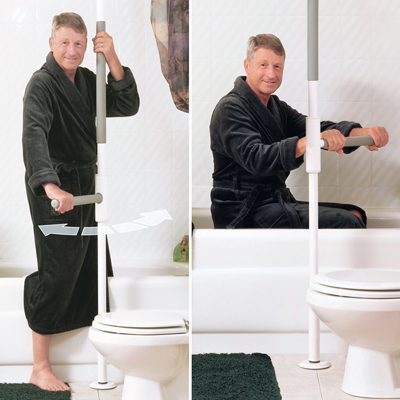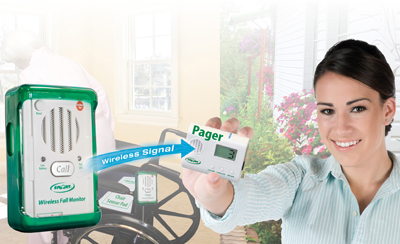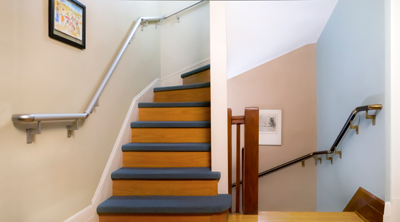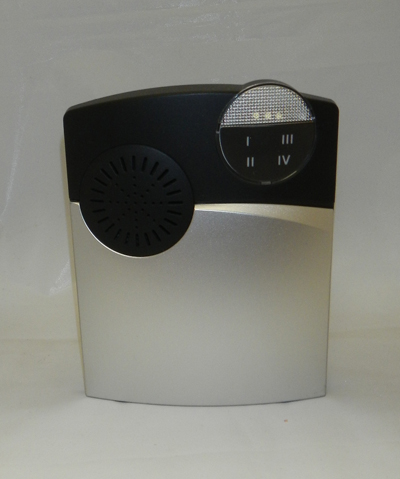The elderly population seeking to age in place is at the greatest risk of falling, and serve as a large segment of the customer base of any HME provider.
A range of products offer ways to prevent falls, and providers are well positioned to serve the emerging market. It could be any provider’s next big cash sales category.
Products include a variety of rail systems, grab bars and electronic sensor systems. Installation of the products is quick and easy—some are even do-it-yourself. But selling the products takes sensitivity and a gentle, but proactive, touch.
“When someone walks into the store, providers should get to know what this customer actually needs, not just what they are asking for,” advises Rob Geller, vice president of marketing and sales, PromenAid, manufacturer of an accessibility rail system. In the case of a new product, customers will not know to ask for it, so sales must be based on a needs-oriented discussion, Geller adds.
Retailers should be careful handling the emotional aspects of a customer having to admit a need for fall prevention products, says Geller. “It’s not productive to talk about preventing falls, it’s better to talk about staying in their homes as long as they can,” he says. “Promenaid isn’t about fall prevention; we’re providing autonomy, mobility and peace of mind.”
 SuperPole with SuperBar can be installed anywhere there is a floor and ceiling, and requires one-hand operation.
SuperPole with SuperBar can be installed anywhere there is a floor and ceiling, and requires one-hand operation.Accessible Hand Rails
PromenAid offers an accessible handrail system that can be run throughout the house, including hallways, stairways, around simple or complex corners, indoor or outdoor. Rails can easily be cut to any length, and brackets can be quickly placed anywhere on the rail to align with wall studs for maximum strength. The rails have an anodized aluminum (satin) finish or a darker, antique bronze finish; end caps ADA wall returns and brackets are triple-plated zinc. The system is attractive, strong and affordable.
In a year of selling the product, Geller says the company has not received a single complaint about how to install the product. PromenAid offers brochures samples that a customer can touch and feel. Store owners can mount the system on their show floor to demonstrate the function. PromenAid products are designed specifically for accessibility, mobility and fall prevention and meet residential and commerical building codes. The hand rail is optimally designed—round with a 1.5-inch diameter to comply with Americans with Disabilities Act (ADA) recommendations. The rails are 1.5 inches from the wall, and the L-shaped brackets are designed so fingers don’t get caught. Each bracket provides an additional 500 pounds of support.
PromenAid makes it easy for HME dealers to sell the product and can provide components on an as-needed basis or in bulk. Geller says most orders are pre-cut and customized to fit a specific job. Some dealers that install the product quote parts and labor costs separately, while others quote jobs based on an all-inclusive cost per foot. Fall prevention guidelines always include three important components—hand rails, no loose carpets and proper lighting, says Geller.
“Falls are the number one cause of injury-related hospitalization for people over 65,” he says. The incidence of falls skyrockets every five years of age beyond 65. “If someone over the age of 80 falls in their home, there is a high likelihood they won’t be returning.” Peace of mind is also an element to selling fall-prevention products to the grown children of an older person. “They want to feel secure that the house is designed and protected for their parents’ safety,” says Geller. “We would like our product to be the children’s representative in the home when they can’t be there.”
 Smart Caregiver offers marketing programs such as “Increase Caregivers’ Freedom” that help
position the product as a benefit to caregivers and users.
Smart Caregiver offers marketing programs such as “Increase Caregivers’ Freedom” that help
position the product as a benefit to caregivers and users.Emphasis on Aesthetics
Aesthetics are important in accessibility products for the home. LiveWell Home Safety Solutions offers a line of two-in-one products called Grabcessories that combine grab bar functionality with common fixtures in a bathroom, such as a toilet paper holder, towel bar, towel shelf, shower grab ring and a curved grab bar. A complete set of five Grabcessories can prevent falls throughout the risky bathroom fall zone, up to several hundred square feet, all for $388. “We have research that shows that if someone needs one grab bar, they probably need three to five, depending on the size of the bathroom and how special the need is,” says Scott Blakley, president and chief innovation officer, LiveWell Home Safety Solutions.
The Grabcessories products have weight capacities up to 500 pounds when mounted in a stud and can also support up to 500 pounds mounted on hollow walls (depending on the substrate). The system is easy to install and includes the anchoring system free in the box.
HME dealers that offer home accessibility services will find it easy to incorporate the products. “Nobody thinks they need a grab bar until they actually fall,” says Blakley.
The products are decorative and non-institutional which makes them appealing and preserves an elderly person’s dignity. The packaging features people of all ages using the product, which helps to remove the stigma for any elderly person resistant to being accommodated.
Displaying products is essential to succeed in the fall prevention category, says Blakley, who recommends every HME provider have a tub and shower set up in their retail store to highlight bathroom products. “One particular HME put in a display and their sales went up 366 percent,” he says.
Crossover sales for any customer coming in for a wheelchair or a cane are also a great opportunity. Each individual Grabcessories product, priced between $49 and $100, could be an easy cash sale. “The growth of the aging population is undeniable,” says Blakley. “If you’re not adding these products, you’re missing out.”
Support Wherever It’s Needed
HealthCraft Products also focuses on preventing falls. The company is owned by an engineer, a retired DME store owner and an occupational therapist, offering field experience and design/production knowledge.
Fall prevention products include the SuperPole with SuperBar, which can be installed anywhere there is a floor and ceiling—beside a chair, a bed, between the toilet and tub—to eliminate reaching. The SuperBar allows the user to pull horizontally, requiring less effort and providing maximum leverage. A 16-inch wide leaning and weight-bearing surface is designed to span across the user’s waist. The user can rest, make adjustments and be fully supported to prevent falls. The horizontal SuperBar is a one-handed operation that requires little dexterity—simply lift, push forward and the bar will automatically lock into the next position to prevent forward or backward falls from loss of balance.
Ian Crawford, who handles marketing for HealthCraft Products, says retailers should seek to instill confidence by offering product knowledge, full-service installation, and home assessment services. He suggests asking a manufacturer for an in-service to boost product knowledge and partnering with a certified contractor for installation if necessary.
“Not every client will want these services, but knowing you provide them makes you the trusted and go-to professional,” he says. “Ensuring products get properly mounted is the first step in making sure customers keep coming back to you.”
Fall prevention products can also be packaged with mobility devices such as walkers, rollators, scooters or wheelchairs. Following up with customers can encourage multiple purchases. A customer who currently has a SuperPole product in their bathroom might need another one in their bedroom or beside their favorite chair. Incentives can also encourage sales, such as free installation or a complimentary reacher thrown in. Any visit to a customer’s home is also an opportunity, says Crawford.
“Offer to do a brief assessment of their needs on a room-by-room basis,” he suggests. “Ask if they have trouble getting out of bed, getting into the tub or up from their mobility aid.” If so, offer to install a product for a one-week trial with a 100 percent satisfaction guarantee. “It may sound risky, but our dealers report a 90 percent success rate. Knowing that they will be safer is peace of mind, and it establishes you as the dealer who goes the extra mile for his or her customers,” adds Crawford.
A demo program can also be successful. Donating products to rehabs and ADL gyms can generate therapist referrals. A label on the product with local dealer information can be seen every day by potential customers. HealthCraft Products also offers catalogs, sell sheets, consumer brochures, product videos, posters and display units.
 PromenAid handrails give users an attractive, strong and affordable fall prevention solution.
PromenAid handrails give users an attractive, strong and affordable fall prevention solution.Retail, Do-It-Yourself Monitoring
Smart Caregiver serves all aspects of fall prevention and mobility monitoring alarms, including fall prevention alarm monitors, pull-string monitors, weight-sensing pads, floor sensing pads and motion sensor fall monitors. The company focuses on end users and sells do-it-yourself products through HME dealers, with systems as low as $29.95 and up to $495.
Particularly appropriate to the shelves of an HME retailer, the company’s TL2016-P system includes a pressure sensor pad, which can be used to sense whether someone is the bed, by the door or in a favorite chair, wired to a monitor that sends a wireless pager alert to a family member or caregiver. The product costs $89.95 and is available in shelf-ready clamshell packaging.
“We are starting to get the word out that this product exists,” says Tim Long, president of Smart Caregiver. “Before, caregivers either didn’t know the products existed, or they heard about high-end systems that were out of their price range.” Smart Caregiver also offers additional components to expand fall prevention possibilities, all using the same core monitor and transmitter.
A system can include a mat by the door, a call button in the bathroom, sensor mats in the bed or in a favorite chair. There is even a $10 sensor pad that goes on a toilet seat.
“Accessories add on for a bigger sale,” says Long. “The customer has full control of someone in his or her care, and doesn’t have to be there watching. This isn’t a one-sale item.” Additional products could add up to $300 or $400 in DIY retail products that can simplify the life of any caregiver, says Long. Long said Internet marketing, especially Amazon, has opened up the market for his products. He estimates sales so far in the $3 million range, but also estimates sales could climb to $20 million as word is spread.
Smart Caregiver’s offer to DME retailers is to guarantee any inventory they put on the shelves. “If it doesn’t sell, we’ll take it back,” says Long. The company also shares half of any marketing costs and supports the local dealer to design promotional materials and mail them out.
Simple, Inexpensive Options
Dakota Alert offers two technology solutions for the elder-care market. One is an 18 x 24-inch battery-operated mat that is placed beside the bed, possibly under a rug. The mat sends a radio signal up to 1,000 feet to alert a caregiver that the home care patient has gotten out of bed and may be wandering or may be at risk of falling. The radio receiver includes lights and a “ding-dong” alarm sound. The simple retail product sells for just over $100.
A second Dakota Alert product is a wireless pull station that is hung alongside a bed, which also sends a radio signal to a caregiver. The radio receiver has a relay output that could be used to trigger an alarm on a security system, for example.
“Many people have a family member who they hope can age in place,” says Jason Quam, vice president of Dakota Alert. “Sometimes there is a simple and inexpensive solution that can prolong their stay at home.” He says the solution might also be used by a neighbor that checks in on a home care patient, as long as they are within the 1,000-foot radio signal range.
Dakota Alert has been in business about 20 years focusing on simple, do-it-yourself solutions to problems using motion detection and other sensors and simple wireless receivers. Various sensors could be used to signal a caregiver if a home care patient enters an area of the home that might present a fall hazard, such as a stairwell.
Providing Relief for Caregivers
The SafePresence 200 system, provided by J. Brasch Co., is a retail product that uses a wireless remote receiver with audio to enable caregivers to talk to a patient by pressing the talk button from anywhere in the house. A base station monitor and transmitter in the patient’s room can be set to no audio to ensure patient privacy, to push-to-talk to allow the patient to communicate with the caregiver whenever needed and always on to allow the caregiver to hear the patient at all times.
The system integrates with bed, chair, and floor sensor pads to enable close monitoring of persons at risk of falls or wandering. There is an extra charge for a choice of disposable pads that can last from 30 days to two years. (The pads’ sensing capabilities degrade over time, and available pads are rated to last for various amounts of time.)
 Dakota Alert offers a selection of technology solutions for the elder-care market.
Dakota Alert offers a selection of technology solutions for the elder-care market.
Another Brasch product is the SafenBed SP 100 alert system, which incorporates a pressure-sensitive pad connected to an alarm located on the night table that sounds if someone gets out of bed in the middle of the night, or if they don’t return within a certain user-specified amount of time. The system costs slightly more than $100.
“Retailers don’t have many options to address the falls issue,” says John Brasch, president of J. Brasch Co., who has more than 30 years of experience in the fall and wandering prevention category. He founded a company to provide WanderGuard wandering and fall prevention equipment to nursing homes; the business was later sold to Stanley Healthcare Solutions. “Institutional products are not particularly applicable to home care,” Brasch says. “Our products reduce the wear and tear on caregivers and allow patients to stay at home longer. We are focused on assisting caregivers to reduce their stress and to moderate the intensity of their activity.” Brasch says his company’s products help combat anxiety and stress among caregivers and patients. “If a caregiver knows a patient is safe in bed, the stress level goes down,” he says. “If you aren’t confident you will know when they get out of bed, you will feel stress.”
The product packaging includes a lot of information for the consumer and to help educate sales people about the product. “It’s not a radical concept, but people don’t know it exists,” says Brasch. “Somebody has to initiate a conversation about it.”
The company also provides a hotline of advisers to answer questions and develop competency of sales people. HME/DME providers interested in the product can contact the company to buy a single product wholesale. After that, the company would expect to sell units in half-dozen quantities or more at a dealer price, shipped out of Lincoln, Neb.
“Staff should be encouraged to offer it as part of their package when they are selling walkers, renting a bed, or other equipment,” says Brasch. “There is a potential for hundreds of sales a year. The best channels are local retailers who know their customers.”
Effective sales involve being proactive in assessing the needs of a family when they are entering a home care situation. Although the product will be offered online, the price won’t undercut what local retailers sell it for. “Most people who want it will want it right now, so if a retailer has stock, it will make a difference,” says Brasch. “This is an ideal situation for a retailer to get a cash sale.”




